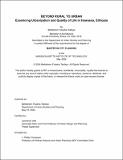Beyond Rural to Urban: Examining Urbanization and Quality of Life in Hawassa, Ethiopia
Author(s)
Tesfaye, Bethlehem Fisseha
DownloadThesis PDF (86.89Mb)
Advisor
Vale, Lawrence
Terms of use
Metadata
Show full item recordAbstract
This thesis examines the rapidly urbanizing, secondary city of Hawassa, Ethiopia, studying patterns of urban growth to determine how different models of planning for urban development can influence quality of life for urban residents in Ethiopia. To do so, it proposes its own operational definition for ‘quality of life’ that constitutes (1) increased commercial activity, (2) access to affordable housing, (3) general health & well-being, (4) healthy environments, (5) access to affordable transportation, and (6) community involvement & sense of belonging. Hawassa is one of many secondary cities in Ethiopia and across Sub-Saharan Africa that are growing at a pace faster than the city can plan for, leading to unsustainable informal settlements that exacerbate inequity. While recent planning models have been put in place to avoid such settlements in Hawassa, such as the Urban Expansion Initiative, the Urban Local Government Development Project, and Special Economic Zones, the progress of these models and their effect on the newly urbanized population has yet to be evaluated. Furthermore, a successful model of urban planning that is self-sufficient, localized to its community, and accountable to the welfare of its population has yet to be defined. This project aims to determine a new standard for the evaluation of future urban development projects in secondary cities that incorporates equitable frameworks for decision-making in the formation of local planning policy and urban design by (1) quantitatively assessing the correlation between urban living and an inherited index for individual wealth, used as a proxy for ‘quality of life’, at a national level; (2) compiling and analyzing existing information and data on Hawassa’s recent urban development; (3) constructing a narrative of Hawassa’s city development through new data gathered from the affected population of Hawassa on attitudes towards urbanization in three key study areas of the city: BahilAdarash sub-city, Tabor sub-city, and the area around Hawassa Industrial Park.
Date issued
2024-05Department
Massachusetts Institute of Technology. Department of Urban Studies and PlanningPublisher
Massachusetts Institute of Technology